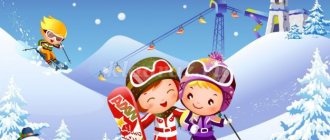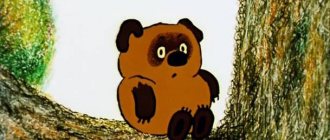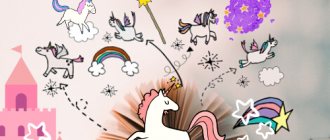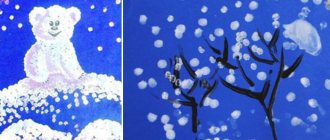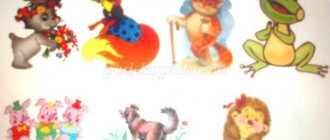Summary of GCD on FCCM using ICT in the senior group “Journey to the Forest”
•Do not shoot birds with slingshots.
•Do not catch birds, do not take chicks home.
Lesovik:
I have a small gift for you. Listen to him (the voice of a nightingale sounds, a video of a nightingale appears on the interactive board) This is a nightingale, not everyone manages to hear it in the forest.
Educator:
Thank you Lesovichok, this is a very good gift, now let’s rest, (a recording of sounds of the forest plays)
Physical exercise.
They raised their hands and shook them - these are trees in the forest.
Elbows bent, hands shaken - the wind knocks down the dew.
We wave our hands smoothly - the birds are flying towards us.
Let us show you how they sit down: their wings are folded back.
Lesovik: Well done guys, they made me happy. Can you handle the next task? Guys, besides birds, who else lives in the forest?
Children:
Wild animals live in the forest.
Educator:
Let's show Lesovich how we know wild animals. We'll play games now.
•Game “Four wheel” (animals)
•Game “Cut pictures” (animals)
Lesovik:
Yes, guys, many living creatures live in my magical forest, it’s impossible to list them all. Guess some of them.
All four petals of the flower were moving.
I wanted to pick it off - it fluttered up and flew away. (butterfly)
Look at the fellows: cheerful and lively.
Material for construction is dragged from all sides. (ants)
Black, not a raven, horned, not a bull. with wings, not a bird. (bug)
From branch to path, from grass to blade of grass.
A spring jumps, a green back. (grasshopper)
A housewife flies over the lawn.
If he fusses over a flower, he will share the honey. (bee)
Blue airplane sitting on a white dandelion (dragonfly)
It will hit, weave, sit and wait for prey. (spider)
(as you solve riddles, images of insects appear on the interactive board)
Lesovik:
Well done guys, you have proven that you know a lot about the forest, its inhabitants, and you can behave well in the forest. Guys, be sure to come visit again, you can learn a lot of interesting things about the forest. You made me happy today, I want to reward you with these “Friend of Nature” medals. As a parting gift, I give you this book (about the forest).
(children say goodbye to Lesovichok)
Educator:
Well, guys, our journey has come to an end and it’s time for us to return to our beloved kindergarten. Let's close our eyes and turn around ourselves. Here we are in our group. Let's remember where we were? (We were in the forest) What did we do? (We found and explained signs about the rules of behavior in the forest. We named migratory and wintering birds. We talked about how we can help the birds. We played the game “Odd Four.” We played the game “Cut Pictures.” We guessed riddles).
Publication address:
Summary of a lesson using ICT in the middle group “Visiting the forest dwellers”
Summary of a lesson using ICT in the middle group “Visiting the forest dwellers”
Target:
Give children ideas about the hedgehog: its appearance, movements, nutrition, habits; expand and deepen existing knowledge.
Tasks:
Educational:
To form a holistic picture of the world through getting to know the hedgehog: its appearance, movement, nutrition, habits, with its offspring, to broaden the horizons of children.
Fix the names of baby animals.
Continue to develop coherent speech, the ability to answer questions, activate children’s vocabulary (beast, cub, hedgehog, hedgehogs, form children’s vocabulary (hedgehog, hedgehog, hedgehogs)
.
Educational:
Continue to develop skills in cognitive and research activities.
Develop memory, thinking, logic (the ability to draw conclusions and conclusions, attention (the ability to see the main thing, motor activity, tactile sensations, fine motor skills, creative skills and abilities.
Continue to develop children's gross motor skills.
Educational:
Cultivate an interest in the lives of animals, the ability to empathize, a desire to help...
Foster a caring attitude towards living nature.
Develop the ability to listen to each other.
Foster a value-based attitude towards one’s own work and the work of other children.
Integration of educational areas: cognitive development, speech development, social and communicative development, physical development, artistic and aesthetic development.
Materials and equipment:
Models of trees, model of a door. Presentation showing: “Photos of hedgehogs, a story about their lifestyle, appearance, nutrition, habits.”
Toys: cat, bird, squirrel, hedgehog
;
Handout: Hedgehogs cut out of paper, clothespins for “needles”
(model of a clearing for hedgehogs.)
Musical accompaniment:
Music Center.
Disc (melody “Sounds of Nature”
,
"Voices of nature. Hedgehog"
).
Preliminary work:
Looking at illustrations of a hedgehog.
Reading of S. Marshak’s poems “A Quiet Tale”
,
"The Tale of a Smart Mouse"
.
Guessing riddles about forest animals.
Progress of the lesson.
Start of class in the group room
.
Educator: Guys, guests have come to us, let's say hello.
There is a good sign to give greetings to everyone in the morning.
Red sun. Hello!
Clear sky. Hello!
People are adults and children.
Hello to you from the bottom of my heart! (together)
There is a knock on the door.
Educator: Guys, hear them knocking. Let's see who came to us.
They open the door. The children see that there is no one there, only traces of someone’s legs.
Educator: Guys, whose tracks are these?
Presumable answers from children.
Educator: Interesting! Let's follow his trail and find out who knocked on the door and why and ran away.
Summary of GCD using ICT technology lesson plan (senior group)
Summary of the GCD “What is friendship?” in the senior group using ICT technology
Goal: to bring children to an understanding of what friendship is.
Tasks:
Educational: to form children’s ideas about friendship; will consolidate children's knowledge about positive and negative situations; to ensure that children acquire the ability to evaluate the actions of their peers in joint games and situations.
Developmental: development of constructive relationships in a peer group.
Educational: cultivate goodwill, cooperation skills.
Methods and techniques: conversation, game, exercises, viewing a presentation.
Materials and equipment: a ball, an envelope with a letter, whatman paper with drawn bags, pictures with situations, green and red traffic lights, circles with a diameter of 4-5 cm on one side - green, on the other - red.
Educational technologies:
- game training (game technique “Tangle”, exercise “Dark and light bags”, exercise “Traffic light”);
- health-saving technologies (physical education);
- ICT (CD: multimedia presentation, audio recording of songs).
Preliminary work: familiarization with sayings about friendship, reading fiction, looking at paintings.
Progress of educational activities:
1. Organizational point:
Educator: Guys, I brought a magic ball, and it is magical because now each of you will be able to express good thoughts and feelings towards your peers.
Game technique "Tangle".
-What does a ball look like? (sun, bun. Children sit in a circle, the first child unwinds the ball, and clamps the end of the thread and passes it to the person sitting next to him, while calling his name, and talking about the good qualities of his friend (I really like playing with you, you are so kind, we good friends with you, etc.) and so they unwind the ball.)
Educator: That’s great, how many wonderful words you said. Well done to all of you!
The “Song of Friendship” comes on, the children come up to the teacher and stand around her.
Educator: Do you think those who know how to be friends take care of their comrades and try to do something good for them?
Children's answers.
2. Preparation for mastering program material through updating background knowledge.
Knock on the door (the postman brought a letter)
— Hello, group “………” You have a letter, please receive it and sign it.
The teacher reads the letter: “Attention, attention, alarm! The insidious witch Zlyuchka is approaching our kindergarten “Ladushki”, she wants to steal our happiness. Help urgently needed! Guys, don't let this happen!
Educator: Guys, what are we going to do? After all, our help is urgently needed.
Children's answers.
Educator: To help us, we need to find out what the happiness is that the Evil One wants to steal? And these pictures will help us with this.
3. Familiarization with new material.
1st slide (a group of children playing together)
Educator: Do you think they are friends? How did you guess?
Children's answers.
Educator: Well done guys, you understood everything correctly, look how happy they are, they feel good together. It’s not for nothing that they say: “Don’t have a hundred rubles, but have a hundred friends.”
Educator: Let's see where friendship begins? (with a smile)
2nd slide (children with smiles on their faces)
Educator: Guys, do you think it is more pleasant to communicate with a person who smiles or who is angry and gloomy?
Children's answers.
Of course, that’s right, with those who smile, look how happy their faces are.
I also want to share my smile with you, and you will share your beautiful smiles with me.
Educator: There is a phrase: “A smile will make everyone brighter.”
3rd slide (one child helps another in trouble)
Educator: What can you say about this picture?
Children's answers.
Educator: That's right, friends should help each other. Listen to this saying: “Friends are known in need” and a true friend will always come to the rescue.
4th slide (children play with each other)
Educator: Guys, do you think it’s more fun with friends or better alone? Why?
Children's answers.
Educator: It’s not for nothing that they say: “It’s more fun together!” Do you guys know that a person can be in a bad mood, but I know what to do about it and I can teach you.
Children stand near their seats.
Physical education
| The mood has dropped | (spread your arms out to the sides and down, shrug your shoulders sadly) |
| Things get out of hand... | (raise your arms and lower them smoothly) |
| But all is not lost yet, | (finger left - right) |
| If you have a good friend. | (point to friend) |
| Let's handle this together, | (put your hands on your friend's shoulders) |
| Let's breathe a sigh of relief - oh | |
| Let's lift your spirits | (squatted down, stood on tiptoes and raised hands up) |
| And shake off the dust! | (dust off hands) |
4. Primary comprehension and consolidation of the material in practice.
Educator: Now I know that you know how to cheer up, you can play.
Game exercise “Dark and light bags” and “Traffic lights”.
Two large bags are drawn on a piece of whatman paper, we take out pre-prepared pictures that depict good and bad situations and invite the children to individually classify these situations into “dark” and “light.” At the same time, “dark” will be understood as those situations that interfere with living peacefully and happily, both for the person himself and for those around him. Accordingly, under “bright” are those situations that help. Each child is given a picture. One by one, the child goes to the board with his picture and determines which bag his situation belongs to. The children are also given green and red “traffic lights” - circles from whatman paper, green on one side, red on the other, with a diameter of approximately 4-5 cm. When one child comes to the board, the rest of the children show with a “traffic light” whether he has correctly identified the situation or No. "Yes" is green, that's right. "No" - red, incorrect.
Educator: You guys are great, I saw only the correct answers.
5. Summing up the organizational activity.
Educator: Guys, do you think we did it?
Children's answers.
Educator: We proved to Zlyuchka how friendly we are! Friendship is our happiness and we will not give it to anyone!
The teacher reads a poem while simultaneously showing slides.
Friendship warms in the fierce frost,
With a friend, even a sea of tears dries up.
Friendship is a bright star in the sky!
Friendship is happiness for everyone, everywhere, always!
